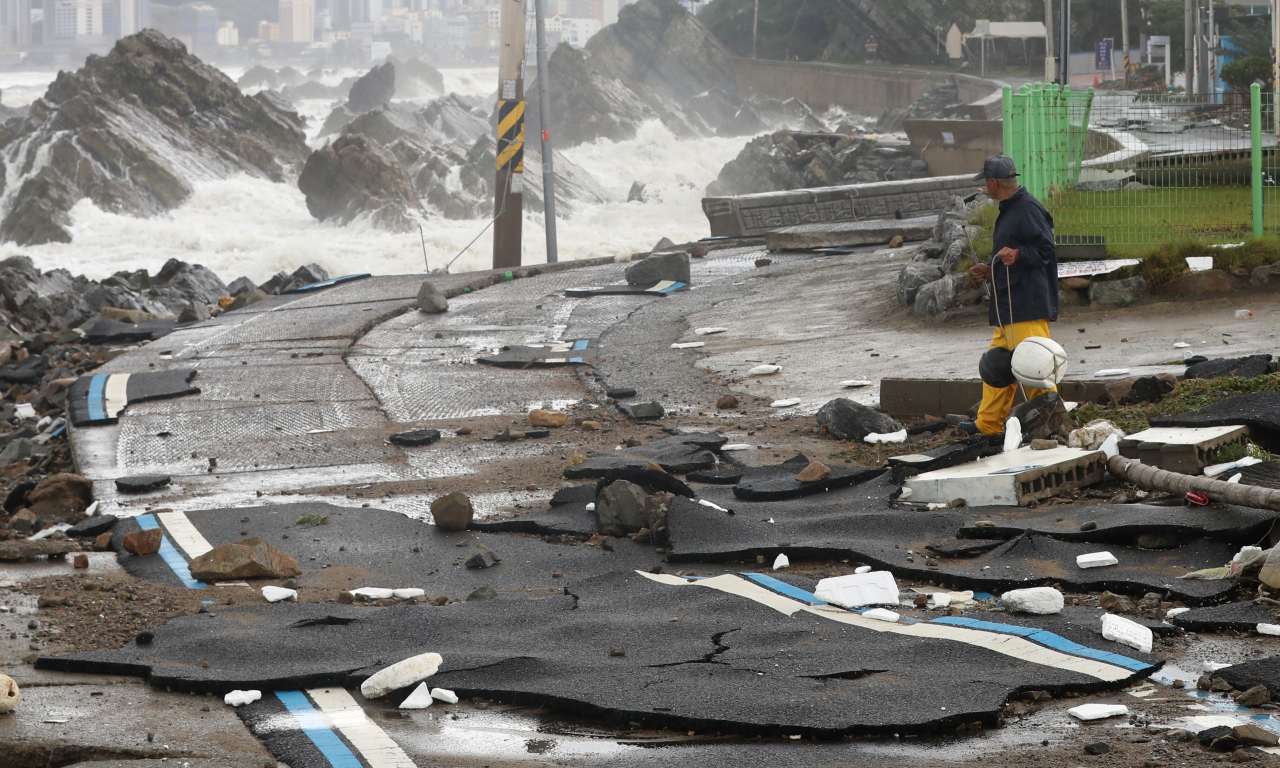 |
A road is damaged as waves hit a shore in Ulsan, Tuesday. (Yonhap) |
Typhoon Hinnamnor, the 11th typhoon this year, passed South Korea on Tuesday, leaving several dead and missing, and dealing severe damages to cities on the east coast.
As of 6 p.m., three people were confirmed dead, and nine missing.
The government on Tuesday morning reported one dead and two missing. But, later in the afternoon, the government updated the tally, which included three deaths and nine missing people.
The official tally was updated as seven additional people were reported missing in an apartment complex in Pohang, North Gyeongsang Province. The missing people are reported to have entered an underground parking lot at an apartment complex to move their vehicles as water flooded the parking lots. In another apartment complex in Pohang, a woman, who was in her 60s, was found dead as she tried to move her vehicle in an underground parking lot.
In Gyeongju, an 80-year-old woman was also found dead, increasing the death toll to three, as of 6 p.m. on Tuesday.
President Yoon Suk-yeol is said to be considering visiting Pohang as the search goes on for the missing.
South Korea sped up its assessment of damage caused by Typhoon Hinnamnor after the country was clear of the typhoon’s influence in the afternoon.
According to the Korea Meteorological Administration, the super typhoon passed Jeju Island at midnight and made landfall on the southern coast of the country at 4:50 a.m. Tuesday. The typhoon then headed back out to sea at 7:10 a.m.
At 9 a.m. Tuesday, Typhoon Hinnamnor moved northeast at a speed of 62 kilometers per hour near Ulleung Island, an island east of the Korean Peninsula. The typhoon’s atmospheric pressure reached 965 hectopascals at its center, with a maximum wind speed of 37 meters per second.
Typhoon Hinnamnor was expected to pass the northeastern coast of Ulleung Island -- 330 km away from the island -- at around 3 p.m. and approach an area 420 km away from Sapporo, Japan at 9 p.m.
The typhoon is expected to weaken further and become an extratropical cyclone once it approaches Sapporo, the state weather agency said.
As the typhoon moved away from the country, South Korea also lifted typhoon warnings in most areas, with some exceptions in the coastal regions in the early afternoon, Tuesday.
Despite its quick landfall, Typhoon Hinnamnor dumped heavy rains in the southern part of the country, as well as in Jeju Island.
Between Saturday and Tuesday morning, the mountain area in Jeju had an accumulated rainfall of 1,058 millimeters. Gyeongju, South Gyeongsang Province, also had 447.5 mm of rain, followed by 418.2 mm in Pohang, North Gyeongsang Province. Ulsan also had 385.5 mm of rain.
The National Fire Agency said 13 people have been rescued from nine accidents that took place under the influence of Typhoon Hinnamnor.
A total of 66,341 homes suffered power outages, and around 45 percent of them have been recovered, according to Korea Electric Power.
The number of people who were temporarily evacuated for safety concerns came to 2,906 from 2,141 households. In South Gyeongsang Province, 1,621 people were evacuated, followed by 697 people in South Jeolla Province. In Busan, 379 people were evacuated from their homes. Seoul only reported three people from two households temporarily left their houses.
A total of 71 houses and eight commercial buildings were reported to have been inundated nationwide as 3 p.m. on Tuesday, while four houses were reportedly destroyed.
Farmlands in the country also reported damages. The government said a total of 1,320 hectares of farmlands have been damaged nationwide, with 477 hectares in South Gyeongsang Province, 411 hectares in South Jeolla Province, 280 hectares in Jeju Island and 115 hectares in North Gyeongsang Province.
Typhoon Hinnamnor was previously expected to be one of the strongest typhoons that South Korea has ever embraced. In terms of atmospheric pressure, Typhoon Hinnamnor ranked third at 955 hpa, following Typhoon Maemi’s 955 hpa.
In terms of maximum wind speed, Typhoon Hinnamnor, however, came in eighth place with a maximum wind speed of 37.4 meters per second, significantly lower than Maemi’s 51.1 mps.
The less strong winds could have helped the country avoid severe damage from the typhoon, said Woo Jin-kyu, a senior analyst at the weather agency. However, Woo stressed that the winds were still strong enough to cause significant damage, and the days of taking precautionary measures prior to the typhoon’s arrival mainly helped the country avoid severe damage, unlike the case of Maemi in 2003.



![[Herald Interview] 'Trump will use tariffs as first line of defense for American manufacturing'](http://res.heraldm.com/phpwas/restmb_idxmake.php?idx=644&simg=/content/image/2024/11/26/20241126050017_0.jpg)

![[Health and care] Getting cancer young: Why cancer isn’t just an older person’s battle](http://res.heraldm.com/phpwas/restmb_idxmake.php?idx=644&simg=/content/image/2024/11/26/20241126050043_0.jpg)

